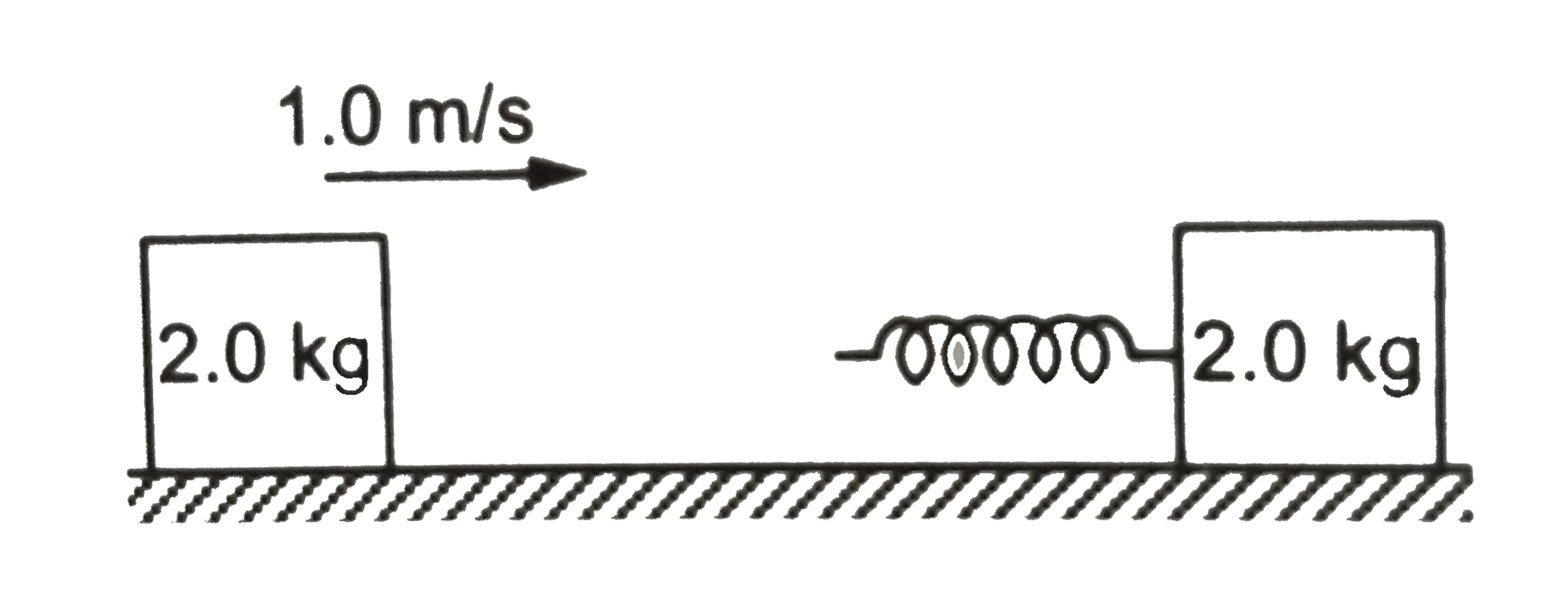A block of mass 2.0 kg is moving on a frictionless horizontal surface with a velocity of 1.0 m/s figure towards another block of equal mass kept at rest. The spring constant of the spring fixed at one end is 100 N/m. Find the maximum compression of the spring.
 Solution in Tamil
Solution in Tamil
Mass of each block MB=2kg
Initial velocity of the 1st block
v=1msec
Va=1msec
Vb=0msec
Spring constantof the spring =100N/m

The block A strikes the spring with a velocity 1m/sec.
After teh colision, its velocilty deceases continuously adn at an instant the whole system(Block A+the compound spring +Block B) moves together wilth a common velocity.
Let teh velocity be V.
Using conservation of energy,.
(12)MAV2A+(12)MbV2B
=(12)MAV2+(12)MBV2+(12)kx2
(12)×2(1)2+0
=(12)+(12)xv2+(12)x2×100
(whenx=maxiμmcompresionofspr∈g)<br>rarr 1−2v2=50x2..........i
AsthereisnoexterNAlforce∈thehorizontaldirection,themomentumshod––beconserved.<br>rarr M_AV_A+M_BV_B=(M_A+M_B)V<br>rarr 2xx1=4xxV<br>rarr V=(1/2)m/sec.....ii<br>pu∈g∈equatio∩i<br>1=2xx(1/4)+50x^2<br>rarr (1/4)=50x^2<br>rarr (1/4)=50x^2<br>rarr x^2=1/100m^2<br>rarr x=(1/10)m<br>=0.1m=10cm
Topper's Solved these Questions
Similar Questions
The centre of mass of a system of particles is at the origin. It follows that:
05:52View SolutionAn aluminium vessel of mass 0.5kg contains 0.2kg of water at 20∘C A block of iron of mass 0.2kgat100∘C is gently put into the water .Find the equilibrium temperature of the mixture, Specific heat capacities of aluminium , iron and water are 910Jkg−1K−1470Jkg−1K−1and4200Jkg−1K−1 respectively
04:45View SolutionFind the accelerationof the moon with respect to the eath from the following data, Distance between the earth and the moon =3.85×105 km and the time taken by the moon to complete one revolution around the earth =27.3days
04:04View SolutionEach of the blocks shown in figure has mass 1 kg. The rear block moves with a speed of 2 m/s towards the front block kept at rest. The spring attached to the front block islight and has a spring constant 50 N/m. find the maximum compression of the spring.
 02:14View Solution
02:14View SolutionA block of mass 2.0 kg is moving on a frictionless horizontal surface with a velocity of 1.0 m/s figure towards abnother block of equal mass kept at rest. The spring constant of the spring fixed at one end is 100 The spring constant of the spring fixed at one end is 10 N/m. Find the maximum compression of the spring.
02:54View SolutionA block of mass m is attached to one end of a mass less spring of spring constant k. the other end of spring is fixed to a wall the block can move on a horizontal rough surface. The coefficient of friction between the block and the surface is mu then the compession of the spring for which maximum extension of the spring becomes half of maximum compression is .
05:29View SolutionA block of mass 4kg slides on a horizontal frictionless surface with a speed of 2m/s. It is brought to rest in compressing a spring in its path. If the force constant of the spring is 400N/m, by how much the spring will be compressed
09:23View SolutionA block of mass m = 25 kg on a smooth horizontal surface with a velocity vec v = 3 ms^(-1) meets the spring of spring constant k = 100 N//m fixed at one end as shown in figure. The maximum compression of the spring and velocity of block as it returns to the original position respectively are. .
04:11View SolutionA block of mass 2 kg is moving on a frictionless horizontal surface with a velocity of 1m//s towards another block of equal mass kept at rest. The spring constant of the spring fixed at one end is 100 N//m. Find the rnaximum compression of the spring
05:55View SolutionA spring-block system is resting on a frictionless floor as shown in the figure. The spring constant is 2.0 N m^(–1) and the mass of the block is 2.0 kg. Ignore the mass of the spring. Initially the spring is in an unstretched condition. Another block of mass 1.0 kg moving with a speed of 2.0 m s^(–1) collides elastically with the first block. The collision is such that the 2.0 kg block does not hit the wall. The distance, in metres, between the two blocks when the spring returns to its unstretched position for the first time after the collision is _________.
06:03View SolutionA block of mass m is initially moving to the right on a horizontal frictionless surface at a speed v. It then compresses a spring of spring constant k. At the instant when the kinetic energy of the block is equal to the potential energy of the spring, the spring is compressed a distance of :
03:52View Solution9 किलोग्राम द्रव्यमान का एक पिण्ड घर्षण रहित पृष्ठ पर4m/s के वेग से गतिशील है। यह पिण्ड एक आदर्श स्प्रिंग से टकराकर तथा उसे सम्पीडित कर विरामावस्था में आ जाती है। यदि स्प्रिंग का बल नियतांक 100 N/m हो , तो स्प्रिंग में कितना सम्पीडन होगा ?
03:24View Solution8 kg का एक गुटका घर्षण रहित पृष्ठ पर 4 m/s के वेग से गतिमान है । यह गुटका स्प्रिंग को संपीडित करके विरामावस्था में आ जाता है। यदि स्प्रिंग नियतांक 2×104 N/m हो , तो स्प्रिंग कितना संपीडित होगा ?
06:01View SolutionM द्रव्यमान का एक गुटका जो घर्षणशील क्षैतिज सतह पर गति कर रहा है K स्प्रिंग नियतांक की एक स्प्रिंग से टकराता है तथा इसे L दूरी संपीडित करता है। संघट्ट के पश्चात गुटके का अधिकतम संवेग है-
 04:54View Solution
04:54View Solution16 kg. A block of mass moving on a frictionless horizontal plane at a velocity of 4 m / s, compresses a spring to a break state. If the force constant of the spring is 100 N / m then how compressed will the spring be
View SolutionEach of the blocks shown in figure has mass 1 kg. The rear block moves with a speed of 2 m/s towards the front block kept at rest. The spring attached to the front block islight and has a spring constant 50 N/m. find the maximum compression of the spring.
 View Solution
View Solution

